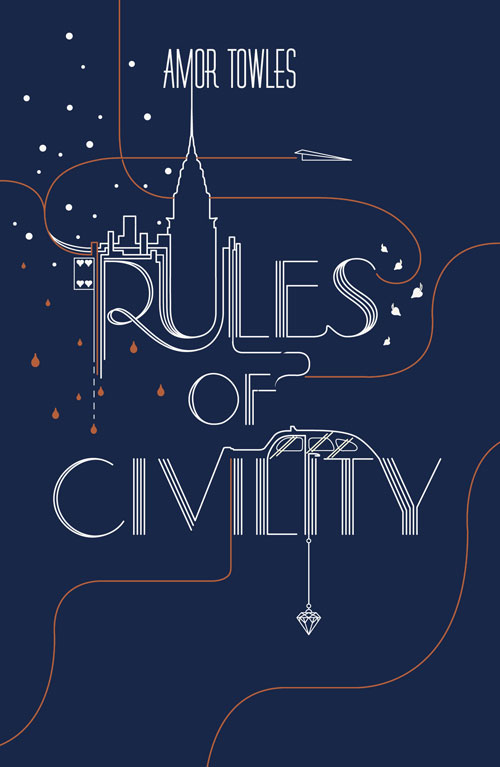One of the best and most rewarding aspects of reading is discovering a new author you enjoy. Once you read your first of their novels, you rush to check out their other works, and suddenly a new door of stories and adventures opens to you.
Amor Towles provided me with this gratifying feeling over the course of the last year. Towles authored three critically acclaimed novels, each known for their unique storytelling and carefully crafted characters, and I consumed each voraciously.
The first Towles novel I read was “A Gentleman in Moscow,” which is the most well-known of his work (and now a mini-series on Paramount). Towles creates a compelling tale in which the main character is imprisoned inside a luxury hotel for nearly the entire novel. The setting and circumstances Towles restricts himself to showcase his ability to develop fresh and intriguing storylines.
While “A Gentleman in Moscow” catapulted Towles into the spotlight, it was his inaugural novel, “Rules of Civility”, that first earned him his reputation as a cunning and skilled novelist. Its somewhat unexpected success led Towles to quit his job as an investment professional and pursue writing full-time.
I recently completed my journey through the worlds of Amor Towles’ after I finished “Rules of Civility”, and it earned a spot as a close second behind “A Gentleman in Moscow” on my list of my favorite Towles’ works.
“Rules of Civility” transports readers to post-Depression New York in the late 1930s through the eyes of a 25-year-old Katy Kontent. As a young, ambitious secretary Katy uses her intellect and sharp wit to climb New York’s social and professional ladders, in an era when the city was alive with a reinvigorated energy.
My favorite aspect of the novel, and nearly every one of Towles’ novels, was the dialogue. Each conversation Katy engages in is riddled with wit and sharp remarks but manages to never feel inauthentic or pretentious to the reader. Katy also sprinkles her opinion on all types of matters throughout the book.
Early in Katy’s experience in New York City, Katy comments, “The trick of New York, I was learning, was that nobody was a native, but if you could fake it long enough, you might just convince yourself you belong there.”
It’s quotes like these that keep the reader entertained throughout, and Towles maintains a healthy balance between these quips and real dialogue between characters so the discourse never becomes dull.
Towles’ creation and development of his characters is another area he excels in, and it helped make “Rules of Civility” a captivating read. We witness the rewarding transformation of Katy Kontent, as she begins as a secretary with little money or status, but she propels herself into an esteemed position through her will and intellect. Apart from her professional transformation, we also witness personal growth in Katy as she wrestles with her identity and values throughout the story.
For example, Katy first experiences the luxurious side of New York City very early in the novel, with the charismatic and polished Tinker Grey. Upon her introduction to the upper echelon of New York City, Katy is in awe and desires to one day obtain and live in the wealth she witnesses. However, by the novel’s conclusion, Katy realizes the superficiality of the life she formerly idolized, and she understands the importance of genuine relationships instead.
Each one of Towles’ other main characters is also written with a significant amount of depth and nuance. Katy’s early interactions with her impulsive best friend Eve Ross tell the reader more about the character’s personalities. Specifically when the two women encounter the wealthy Tinker Grey in a jazz bar on New Year’s Eve. While Katy is more observant and thoughtful, Eve draws Tinker’s attention through her boldness and spontaneity, leading to a relationship between the three that significantly influences the trajectory of their lives.
The way Towles’ characters react to tragedy and major events throughout the novel is another method he utilizes in his characterization. This can be seen specifically through the contrasts between Eve and Katy in their behavior around Tinker Grey when the three of them become somewhat involved in a love triangle.
One area Towles seemed to gloss over was the economic and racial inequalities that were very prevalent in the 1930s. It felt as if Towles believed it would have been inconvenient for him to have to include this in his story, which he published in 2011, so he chose to essentially ignore it. However, the novel is historical fiction and isn’t meant to be a direct commentary on 1930s New York.
Overall, I loved the book and devoured it within a few weeks. It is a cunning story that keeps you engaged throughout, and Towles creates a sleek, aloof aura in the book that made me wish I could witness the fast-paced, jazz-filled streets of Manhattan.
4/5









